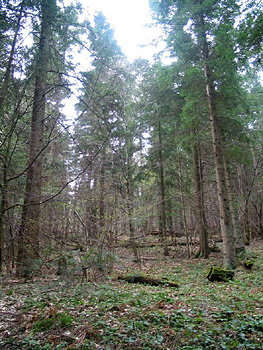Nature » Animated nature » Plant communities
Plant Communities of the MNP
The Magura National Park lies within the geographical range of two plant layers: foothills and forest zone.
The layer of foothills, reaching up to 530 m a.s.l., covers the 43% of the Park’s territory. The fragments of natural forest communities were preserved here, yet the planted stands with a predominance of Scots pine dominate. In the non-forest areas meadow and pasture communities as well as law moors are quite numerous. The forest zone layer, spreading from the altitude of 530 m to the summits (57% of the Park’s territory), is to be found in an island form, covering the higher parts of the hills. Only on the Magura Watkowska range it forms a bigger complex. In this layer forests, mainly beechwoods, dominate. The fir forests and artificial pine and mixed forests are less popular.

Carpathian Beechwood (phot Andrzej Czaderna)
As a result of phytosociological research carried out due to the Preservation Plan of the MNP the plant communities were precisely distinguished.
The Magura National Park is of the forest character. The forest and shrub communities cover 93,79% of the Park’s territory, while the non-forest communities – natural and synanthropic cover only 6,21% of the area.
In the MNP 57 plant communities in the rank of the association or other equivalent units were distinguished. Forests and shrubs are represented by 16 natural communities and several tree stand of a forecrop type not yet included in particular associations.
Wet forests and riverine carr cover small area. The following associations were found: swamp alder wood (Ribo nigri – Alnetum, Caltho – Alnetum), fragments of submountainous riverine carr Carici remotae – Fraxinetum, riverine carr Alnetum incane and community Aegopodium podagrania – Fraxinus excelsior.

Riverine carr (phot. Jaroslaw Sochacki)

Aegopodium podagraria - Fraxinus excelsior forest (phot. Jaroslaw Sochacki)
Very valuable communities are rare in the Polish Carpathians mountain sycamore forests, represented here by 3 associations. The Carpathian sycamore forest Sorbo-Aceretum can be found only at the summit rocks of Kamien Mt., the mountain sycamore forest with hart’s-tongue Phyllitido – Aceretum was discovered at Kamien Mt. and Suchania Mt. in the Wisloka gap, but only the sycamore forest with honesty Lunario-Aceretum is more common. The linden – hornbeam forest Tilio – Carpinetum is also quite rare, it can be found mainly on the steep escarpments and in the lower parts of the valley-sides on the rivers and streams.

Linden - hornbeam forest (phot. Jaroslaw Sochacki)

Sycamore forest with honesty (phot. Jaroslaw Sochacki)
Beechwoods are represented by two associations, not very common acidophilous beechwood Luzulo nemorosae – Fagetum and the most widespread in this area Carpathian beechwood Dentario glandulosae – Fagetum, differentiated into 4 subassociations. Very vulnerable is the festucetosum subassociation of the East – Carpathian character and also the wet subassociations – allietosum and lunarietosum .
From the group of fir forests a small fragment of acidophilous Abieti – Piceteum montanum and quite common mesophilous Abies alba – Rubus hirtus can be found in the MNP.

Fir forest (phot. Jaroslaw Sochacki)


